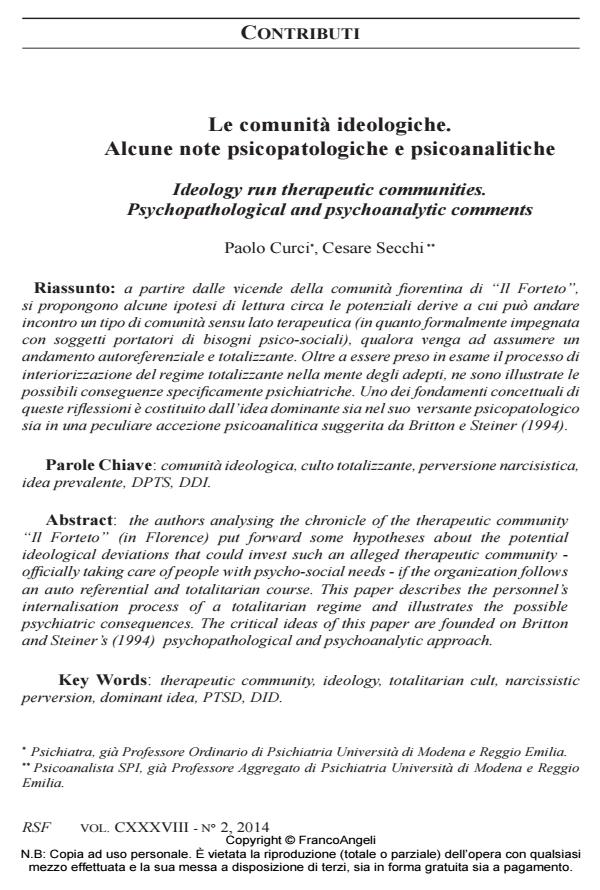Psychopathological and psychoanalytic comments
Journal title RIVISTA SPERIMENTALE DI FRENIATRIA
Author/s Paolo Curci, Cesare Secchi
Publishing Year 2014 Issue 2014/2 Language Italian
Pages 24 P. 145-168 File size 1647 KB
DOI 10.3280/RSF2014-002010
DOI is like a bar code for intellectual property: to have more infomation
click here
Below, you can see the article first page
If you want to buy this article in PDF format, you can do it, following the instructions to buy download credits

FrancoAngeli is member of Publishers International Linking Association, Inc (PILA), a not-for-profit association which run the CrossRef service enabling links to and from online scholarly content.
The authors analysing the chronicle of the therapeutic community "Il Forteto" (in Florence) put forward some hypotheses about the potential ideological deviations that could invest such an alleged therapeutic community - officially taking care of people with psycho-social needs - if the organization follows an auto referential and totalitarian course. This paper describes the personnel’s internalisation process of a totalitarian regime and illustrates the possible psychiatric consequences. The critical ideas of this paper are founded on Britton and Steiner’s (1994) psychopathological and psychoanalytic approach.
Keywords: Therapeutic community, ideology, totalitarian cult, narcissistic perversion, dominant idea, PTSD, DID.
- [1] Caselli L. Il Forteto. Storie e realtà raccontate dal medico di famiglia. Firenze: Edizioni Il Forteto; 1998.
- [2] Ferroni G. Forme di cultura e salute psichica: universo simbolico, ethos, areté e regole di relazione nel mondo del Forteto. Bologna: il Mulino;1999.
- [3] Casanova N. La strada stretta. Storia del Forteto. Bologna: il Mulino; 2004.
- [4] Fornari G, Casanova N. La contraddizione virtuosa. Il problema educativo, don Milani e il Forteto. Bologna: il Mulino; 2008.
- [5] Fiesoli R. Fili e nodi. Cosenza: Falco Editore; 2011.
- [6] Mugnai S, Bambagioni P, Chincarini ML, Locci D, Sgherri M. Relazione finale. Commissione d’inchiesta sull’affidamento dei minori. Regione Toscana; 2013.
- [7] West LJ. A Psychiatric Overview of Cult-Related Phenomena. J. of American Academy of Psychoanalysis 1993; 21: 1-19.
- [8] Tizzani E, Giannini AM. La manipolazione mentale nei gruppi distruttivi. Rivista di Criminologia, Vittimologia e Sicurezza 2011; V, 2: 67-84.
- [9] Beit-Hallahmi B. Apocalyptic Dreams and Religious Ideologies: Losing and Saving Self and World. Psychoanalytic Revue 2003; 90: 403-39.
- [10] Lacter EP, Lehman KD. Guidelines to Diagnosis of Ritual Abuse/Mind Control Traumatic Stress. Attachment: New Directions in Psychotherapy and Relational Psychoanalysis Journal 2008; 2:159-181.
- [11] Goffman E. (1961). Le istituzioni totali. I meccanismi dell’esclusione e della violenza. Torino: Einaudi; 1968.
- [12] Hinshelwood RD. (1987). Cosa accade nei gruppi. L’individuo nella comunità. Milano: Cortina; 1989.
- [13] Armstrong D. Psychic Retreats: The Organizational Relevance of a Psychoanalytic Formulation. Free Associations 2004; 11:57-78.
- [14] Steiner J. (1993). I rifugi della mente. Torino: Bollati Boringhieri; 1996.
- [15] Hinshelwood RD. Ideology and identity: A Psychoanalytic Investigation of a Social Phenomenon. Psychoanalysis, Culture & Society 2009 ; 14: 131-148.
- [16] Bion WR. (1961). Esperienze nei gruppi. Roma: Armando; 1972.
- [17] Freud S. (1930). Il disagio della civiltà. OSF, vol. X. Torino: Boringhieri; 1978, p. 553-630.
- [18] Britton R, Steiner J. Interpretation: Selected Fact or Overvalued Idea? International Journal of Psychoanalysis 1994; 75: 1069–1078.
- [19] Hinshelwood RD. Idéologie et identité: une étude psychanalytique d’un phénomène social. Revue Française de Psychanalyse 2007; 71: 1027-1045.
- [20] McDougall J. (1982). Teatri dell’Io. Milano: Cortina; 1989.
- [21] Chasseguet-Smirgel J. (1985). Creatività e perversione. Milano: Cortina; 1987.
- [22] Freud S. (1905) Tre saggi sulla teoria sessuale. OSF, vol. IV. Torino: Boringhieri;1970, p. 441-536.
- [41] Luxenberg T, Spinazzola J, van der Kolk B. Complex Trauma and Disorders of Extreme Stress (DESNOS) Diagnosis, part one: Assessment. Directions in Psychiatry 2001; 21, lesson 25: 373-392. http://www.aisjca-mft.org/DESNOS.pdf Sito consultato il 15/04/2014.
- [40] Lacter EP, Lehman KD. Guidelines to Diagnosis of Ritual Abuse/Mind Control Traumatic Stress. Attachment: New Directions in Psychotherapy and Relational Psychoanalysis Journal 2008; 2:159-181.
- [39] Keith J. Mind Control, World Control. Kempton, IL: Adventures Unlimited; 1998.
- [38] MacHovec F. Cults: Forensics and Therapeutic Aspects. Behavior Sciences and the Law 1992; 10: 31-37.
- [37] Langone M. Treatment of Individuals and Families Touched by Cult Involvement. Update 1983; 7: 27-38.
- [36] Mullen R, Liuscott RJ. A Comparison of Delusion and Overvalued Ideas. J.Nerv.Ment.Dis. 2010; 198(1): 35-8.
- [35] Yaryura-Tobias JA. An Overview on Delusions, Obsessions and Overvalued Ideas. An Intimate Cluster of Thought Pathology. Clinical Neuropsychiatry 2004; I, 1: 5-12.34.
- [34] Veale D. Overvalued Ideas: a Conceptual Analysis. Behaviour Research and Therapy 2002; 40: 383-400.
- [33] Mc Kenna PJ. Disorders with Overvalued Ideas. Br. J. Psychiatry 1984; 145: 579-85.
- [32] Jervis G. Manuale critico di psichiatria. Milano: Feltrinelli; 1975.
- [31] Šebek M. The Fate of Totalitarian Object. International Forum of Psychoanalysis 1996; 5: 289-294.
- [30] Freud A. (1936). L’Io e I meccanismi di difesa. Vol. I. Torino: Boringhieri; 1978, p. 221-229.
- [29] Anzieu D. L’illusion groupale. Nouvelle Revue de Psychanalyse 1971; 4: 73- 93.
- [28] Freud S. (1921). Psicologia delle masse e analisi dell’Io. OSF, vol. IX Torino: Boringhieri; 1977, p. 257-330.
- [27] Bayle G, Prudent-Bayle A. Institutions et perversions narcissiques. Revue Française de Psychanalyse 2003; 3, 67: 805-18.
- [26] Eiguer A. Outrage à l’intimité. Revue Française de Psychanalyse 2003; 3, 67: 857-71.
- [25] Racamier PC. (1992). Il genio delle origini. Milano: Cortina; 1993.
- [24] Glass J. Group Phantasy: Its Place in the Psychology of Genocide. International Journal of Applied Psychoanalytic Studies 2008; 5:211-221
- [23] Chasseguet-Smirgel J. The Devil Religion: Some Reflections on the Historical and Social Meanings of the Perversions. J. of Clinical Psychoanalysis 1999; 8: 381-400.
Paolo Curci, Cesare Secchi, Le comunità ideologiche. Alcune note psicopatologiche e psicoanalitiche Ideology run therapeutic communities. in "RIVISTA SPERIMENTALE DI FRENIATRIA" 2/2014, pp 145-168, DOI: 10.3280/RSF2014-002010